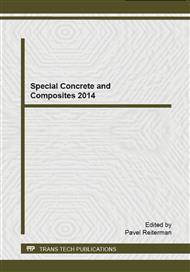[1]
Y. Richard Kim: Modeling of Asphalt Concrete, ASCE Press, 2009 / 460 pp.
Google Scholar
[2]
Hroncová, L., Komačka, J.: Klimatické podmienky Slovenska z hľadiska maximálnych denných teplôt v letnom a zimnom období. Bratislava, Zborník XIII. Seminára Ivana Poliačka Vlyv klimatických podmienok na technológie a konštrukcie v cestnom staviteľstve,: KONGRES management s. r. o., 2008. 26-30 pp. ISBN ISBN 978-80-89275-13-7.
Google Scholar
[3]
Projekt MD ČR 1F45B/066/120 – Zavedení evropských norem týkajících se specifikací materiálu pro zlepšení provozní způsobilosti, životnosti a bezpečnosti dopravy, doba řešení: 2004 – (2007).
Google Scholar
[4]
Máca, P., Sovják, R., Konvalinka, P., Mix design of UHPFRC and its response to projectile impact, International Journal of Impact Engineering, Volume: 63, Pages: 158-163, (2014).
DOI: 10.1016/j.ijimpeng.2013.08.003
Google Scholar
[5]
Holčapek, O., Reiterman, P., Jogl, M., Konvalinka, P., 2014, Destructive and non-destructive testing of high temperature influence on refractory fiber composite, Advanced Materials Research, Vol. 982, pp.141-144.
DOI: 10.4028/www.scientific.net/amr.982.145
Google Scholar
[6]
Reiterman, P., Keppert, M., Čáchová, M., Holčapek, O., Vogel, F., Jogl, M., Kolář, K., Konvalinka, P., 2014, Permeability and basic physical properties of concrete with metakaolin addition, Applied Mechanics and Materials, Vol. 486, pp.313-318.
DOI: 10.4028/www.scientific.net/amm.486.313
Google Scholar
[7]
Kamil E. Kaloush, P.E. a kolektiv, Evaluation of FORTA Fiber-Reinforced Asphalt Mixtures Using Advanced Material Characterization Tests – Evergreen Drive, Tempe, Arizona, Výzkumná zpráva, (2008).
Google Scholar
[8]
Mondschein, P., Souček, V., Vavřička, J., Valentin, J.: Experimentální poznatky s 3D vyztužováním asfaltových směsí. Bratislava, XV. seminár I. Poliačka - Hospodárenie s cestami a PPP projekty: KONGRES management s. r. o., 2010. 63-69 pp ISBN 978-80-970356-4-8.
Google Scholar
[9]
Konvalinka, A.: Experimentální analýza Asfaltocementového betonu (ACB). Diplomová práce 2013, Fakulta stavební ČVUT v Praze.
Google Scholar
[10]
Zedníček, J., Mondschein, P.: Aramidová vlákna – moderní způsob vyztužení asfaltových směsí, http: /www. silnice-zeleznice. cz/clanek/aramidova-vlakna-moderni-zpusob-vyztuzeni-asfaltovych-smesi/, (2014).
Google Scholar
[11]
ČSN 73 6127-3: Stavba vozovek – Prolévané vrstvy – Část 3: Asfaltocementový beton. Praha: Český normalizační institut, (2008).
Google Scholar
[12]
Vavřička, J.: Vlákna v asfaltových hutněných směsích, Fakulta stavební ČVUT v Praze, Diplomová práce, (2010).
Google Scholar
[13]
Máca, P., Jandeková, D., Konvalinka, P., The influence of metakaolin addition on the scaling of concrete due to frost action, CEMENT WAPNO BETON, Volume: 19, Issue: 1, Pages: 1-5, (2014).
Google Scholar


